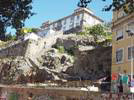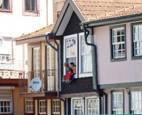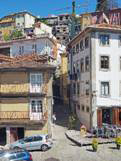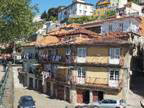| 5/1/2016 PORTO (also called Oporto), Portugal Last night was extremely windy and with that came rough seas. Staff had to make sure all of our deck furniture was securely tied down and after they came back in from our deck it looked as if they had moussed their hair in spikes. Because it was so difficult even to walk we skipped the dining room and called room service. The forced change turned out to be fun. Instead of dressing up we dressed down, into our PJs. Although the rough seas didn′t allow for an evening outing, the constant rocking all night was soothing — we slept like babies. Today was a beautiful, clear, crisp day in Porto. It′s Mother′s Day in Portugal as well as graduation day from Porto University. And it is Sunday. There was a lot going on around town. Among our stops was the old stock exchange with tiles and paintings that were supposed to be worth seeing. We waited in line for fifteen minutes or so and were then told that the "tour" took 45 minutes. At that moment I remembered why I didn′t like museums — tourists go to and want to see the same things I want to see and it takes way too much time to do that in a guided museum tour (which this was). We had a talk with our guide and asked her to focus on showing us where residents of Porto get together and how they spend a typical Sunday (as opposed to lining us up in museums with others like ourselves). Our tour got much better very fast. This city has been a place of commerce for centuries — port wine and fishing among the best known products. We got to see a number of those places, including where fishermen congregate in little communities on the Douro River (the river, which flows through the city, takes them into their Atlantic Ocean fishing grounds).    
We saw the local railroad station. These stations are often places of impressive architecture (think Grand Central Station) but seldom of ground breaking art. I have discussed the fact that both in Porto and Lisbon there is tile art everywhere. On the buildings this tile art tends to be geometric: attractive but repetitive. If it was representative, it tended to be blue (of various shades) and white although the tiles covering the outside of many buildings comes in a variety of colors.
This is the terminal for cruise liners coming to Porto. It sets the tone for the rest of what Porto has to offer. It is breathtaking, inside and out.
|